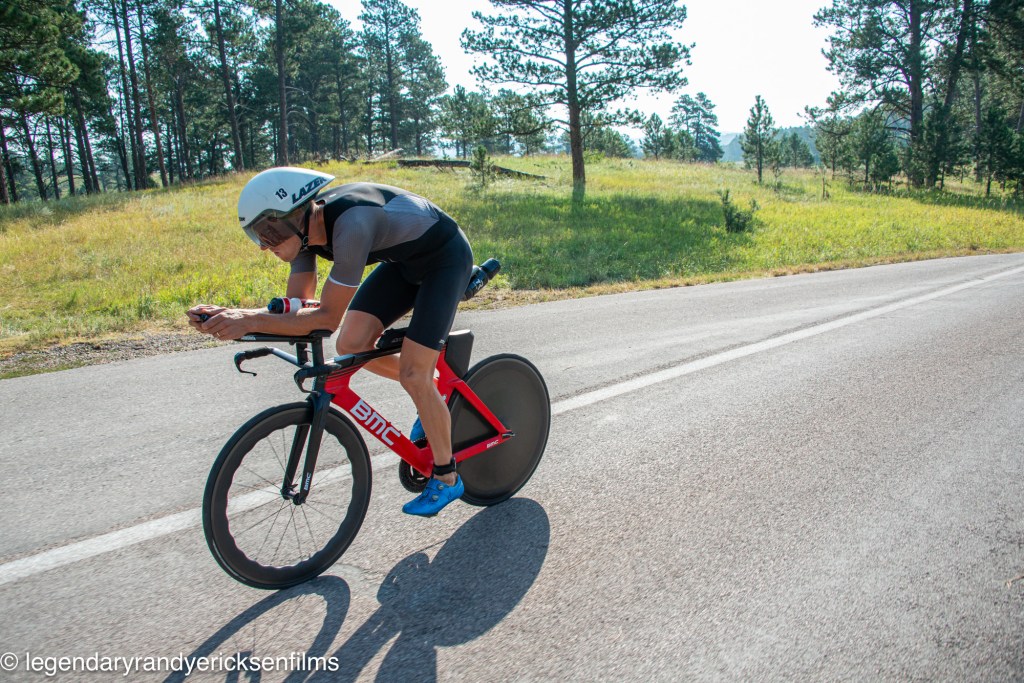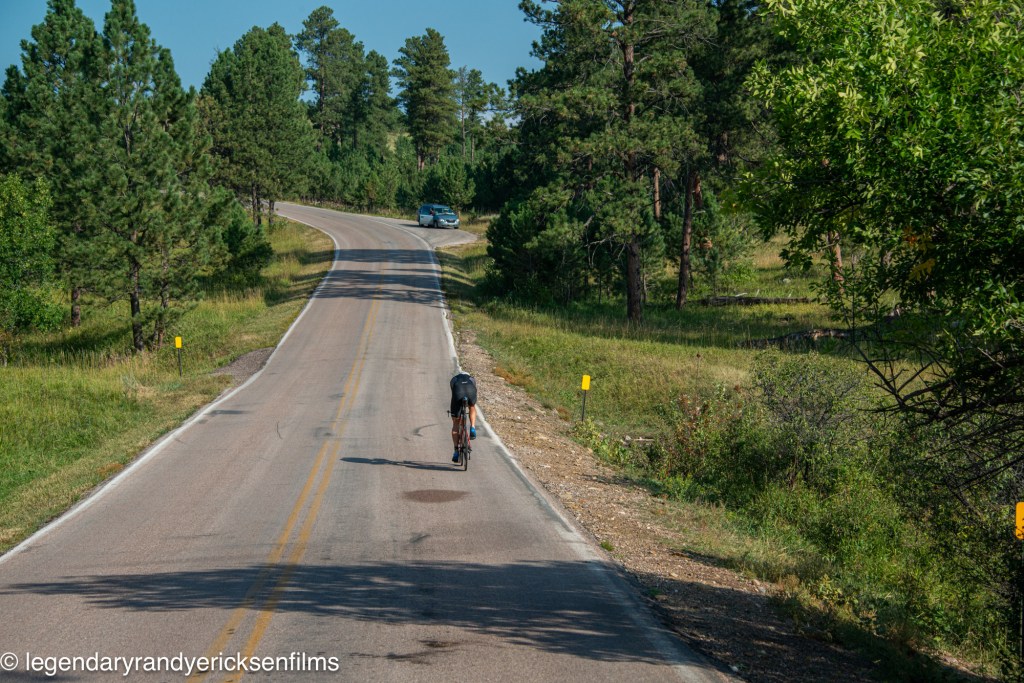Like any good day, my day started at Day’s Inn with waffles and coffee at 6:30 in the morning. I moved about slowly in the below-ground, windowless dining room, knowing there was no reason to show up too early to the race. This year, Wildlife Loop had around 75 competitors split between the 70.3, Olympic, and Sprint distances, and the parking lot was 50 feet from transition. It would take just 15 minutes to rack my bike, rubber band my shoes to my bike (to keep them from spinning while running out of transition), and don a wetsuit. So I sat listening to a TV weather report on repeat, forcing down cheap carbs until just past 7:00.
Race director Brandon Zelfer has always allocated a fair bit of prize money for the 70.3 ever since he started putting on Wildlife Loop 10 years ago, but this year a substantially larger $20,000 purse (contingent on the number of participants) was announced, which drew a half dozen male pros, mostly from Colorado. The seven or eight of us vying for that prize money lined up in chest-deep water as the countdown began. One other racer, possibly competing in the Olympic distance event, chose to start five feet directly in front of us, and refused to move when someone politely suggested he slot in alongside everyone else. “The race director said we could line up wherever we wanted,” he quipped. About seven hours later I came up with the great comeback of, “If that’s true, I’ll start at the third buoy!”
That’s what I should have said!
The guy became a speed bump—I assume he didn’t drown—and caused chaos in a swim start that should have been uncontentious for once.
Since Custer, South Dakota, sits at around 5,000 feet and I 1) don’t swim well at altitude and B) have been living at sea level for two months, I didn’t sprint to close a gap when the fight for position finished 200 meters into the swim. A flashback from Boulder 70.3 in June of having to breaststroke was encouragement enough to just fall in line and rely on my biking ability. This proved to be successful as I and the two other guys I swam with (Taylor Reid and Brand Scheel maybe?) came out of the water just a minute or so behind Ben Deal, who I believe was first out, followed closely by Todd Suttor and possibly one other.
The bike course starts out with a 10-ish mile rolling descent, none of which is very steep. Therefore pedaling is required. I caught Todd by mile four or five and wasted little time passing the RV that he’d just become stuck behind. The course isn’t closed to traffic, so wildlife-gazing tourists tend to clog up this section of the course if you’re going over 30 miles per hour. And the wildlife did not disappoint, because just after I caught Todd, a large herd of mountain goats meandered across the road in front of me. I touched the brakes and cut through a gap, quickly getting back on the pedals in my worry that there were five more guys up the road.

A few miles later I caught Ben, who was in first place, my legs relishing the non 100-degree air temperature that I’ve grown accustomed to in Tucson. I built a 30 second lead by the first turnaround, which I nearly overshot, and began the rolling 10-mile climb, which is broken by multiple descents. I hit the lower slopes pushing threshold power, legs feeling fresh and (as I just mentioned) enjoying the cool weather and the shade offered by the pines. Lately, when it’s been above 95 degrees—which is all of my rides except the two group rides I do that start super early—I have trouble pushing even 180 watts during the warm up, which is incredibly demoralizing. I’ve actually come to believe that training in ‘super heat’ takes about two times the bite out of one’s watts that training at mid-altitude does.

I cruised through the first lap with an average power of 308 (normalized 322)—pretty decent for me on a hilly bike course at 5K elevation. The next lap was less spectacular as I began running out of energy and conserving for the run. I knew the gap to Ben was over four minutes at the second turnaround, and I believed I could hold him off if I had at least a six minute lead off the bike, though that was just a wild guess. I truly had no idea what type of run I’d be capable of since I’d basically shut down my run training three weeks prior due to a hip injury. In fact, despite one of my main goals of the season being to improve my run, I’d hardly done any serious running since May, due to various injuries.

The run started out poorly as my chest cramped all over the place, but thankfully With Enough Caffeine, Shame, and Fear, Anything is Possible™ (a better and more accurate slogan than Ironman’s). By mile two I’d peed and farted out the chest cramps, or something, and began picking up the pace as my asthmatic lungs quieted down. I’d come off the run with about seven minutes and I still had a five minute lead at mile four after the second turnaround. I began conversing with myself about just how hard to push, if I should save energy for the hills, what I’d do if I got caught. I tried convincing myself that I’d still be happy with second place after a good swim and bike. You haven’t been run training anyway. Just pack it in and be content with whatever happens!

Deep down I knew that if I just made it to the halfway point, I’d be willing to die in order to stay in first place, but with nine miles still to go I allowed myself to be a weak-willed-wimp, pardon my French. It had been a long time since I raced hard to the end, and it took a moment to get in the right mindset of taking things mile by mile. Racing is all about living in the moment, and just in case all of your nerve endings are dead, know that this moment sucks and that you’re causing permanent brain damage at the very least™ (another improvement on Ironman’s slogan).

At the halfway point I still had a 4 to 5 minute lead, sitting at an average of 6:20-ish minute per mile pace on a fairly hilly run course. I kept applying pressure, trying to trick myself that the finish line was the last turnaround with 3.5 miles to go. I forced down the last of my gel flask and dumped two bottles of water over my head at the next aid station, finally and truly suffering. Earlier I hadn’t been in any real pain, just anxiety about being caught. Now the pain was digging itself into my legs, stomach, and intestines. It didn’t matter that this was a small race in a place that no one has ever heard of (unless you’ve visited Mt. Rushmore). Maybe this was the last race I’d ever do. Maybe I wouldn’t get around to finishing out the season like I’d been planning, and something would come up in 2024 to spoil my final year of racing. Half-assing it for the next five or six miles to win by a minute was not how I wanted to end things.

By the final turnaround I still had a four minute lead on Ben, who grunted out “it’s yours” or something to that degree as we passed each other on the narrow bike path. I kept running hard until I got to the final climb with two miles to go, then eased up on account of my hip, not wanting to needlessly set its recovery back any further. 11 hard miles was plenty.
I crossed the finish line and my anxiety and the pressure I’d put on myself vanished. Finally a good performance—the first since a year ago at Embrunman. I wouldn’t say that a weight was lifted, but I do feel more confident heading into the next few races this fall. Confident that I’ll be able to perform well (though not necessarily get on the podium or anything) and more importantly confident that, despite the result, I’ll actually be able to enjoy the trip, the excitement of racing, the people, the scenery of a new place, and most importantly the continental breakfasts.
Thank you to everyone who showed up to race, to the volunteers, and to Branden Zelfer and his mom for investing so much of their time, energy, and money into this event.
